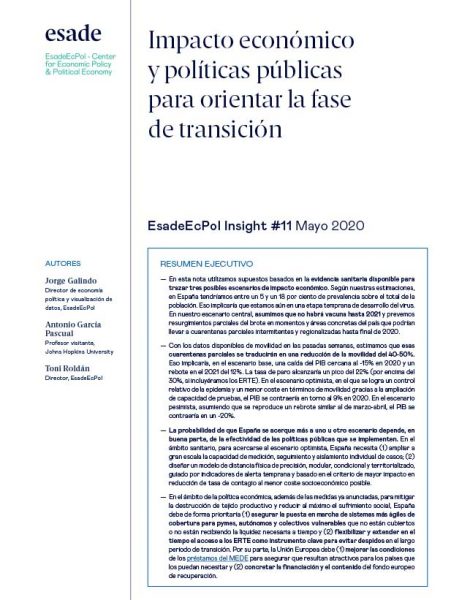
Economic impact and public policies to guide the transition phase
Jorge Galindo, Antonio García Pascual, Toni Roldán
13 May, 2020
EsadeEcPol | Policy Insight
Executive summary
- This article uses assumptions based on available healthcare data to draw up three possible economic impact scenarios. According to our estimates, Spain has a prevalence of between 5% and 18% of the total population. This means that we are still at an early stage of virus development. In our main scenario, we assume that there will be no vaccine until 2021 and we anticipate partial, new outbreaks at certain times and in specific areas of Spain which may lead to intermittent and regionalised partial lockdowns until the end of 2020.
- On the basis of the mobility data available in recent weeks, we estimate that such partial lockdowns will reduce mobility by 40% to 50%. This would mean, in the baseline scenario, that GDP would fall by around 15% in 2020 and bounce back by 12% in 2021. Unemployment would peak at 22% (or above 30% if temporary collective redundancy schemes are taken into account). In the best case scenario, in which the epidemic is more or less brought under control and mobility costs are reduced by greater testing capacity, GDP would shrink by around 9% in 2020. In the worst case scenario, assuming another outbreak similar to the one in March-April, GDP would shrink by 20%.
- The likelihood of one scenario rather than another occurring in Spain depends to a great extent on the effectiveness of the public policies that are implemented. In the sphere of healthcare, in order to achieve the best case scenario, Spain must (1) massively scale up the capacity to measure, monitor and isolate individual cases; (2) design a physical distancing model that is precise, modular, conditional and regionalised, and based on early warning indicators and the criterion of the greatest reduction in the rate of infection at the lowest possible socio-economic cost.
- In the realm of economic policy, in addition to the measures already announced, in order to mitigate the fallout on the economy and minimise social suffering, Spain must prioritise (1) ensuring the implementation of more flexible mechanisms to help SMEs, the self-employed and vulnerable groups not covered or not receiving the necessary cash in time and (2) extending and making access to temporary collective redundancy schemes more flexible because they are a key mechanism for avoiding layoffs during the long transition period. Meanwhile, the European Union must (1) improve the terms of ESM loans to make them attractive to the countries that may need them and (2) define the funding and content of the European recovery fund.

Read the full article:

Antonio García Pascual
Visiting scholar at SAIS, Johns Hopkins & International Board Member, EsadeEcPol
View profile



